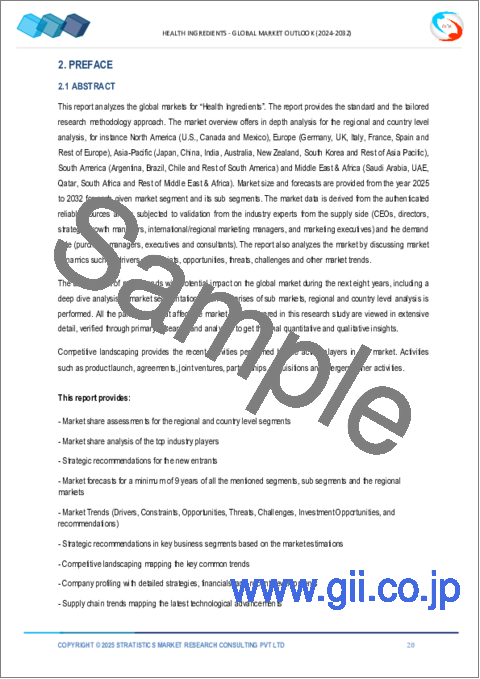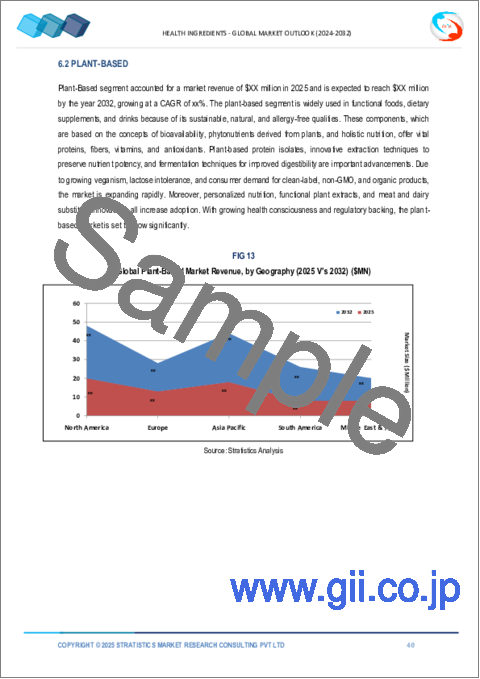|
|
市場調査レポート
商品コード
1603883
2030年までの健康成分市場予測:タイプ、供給源、機能性、用途、地域別の世界分析Health Ingredients Market Forecasts to 2030 - Global Analysis By Type, Source, Functionality, Application and By Geography |
||||||
カスタマイズ可能
|
|||||||
| 2030年までの健康成分市場予測:タイプ、供給源、機能性、用途、地域別の世界分析 |
|
出版日: 2024年11月11日
発行: Stratistics Market Research Consulting
ページ情報: 英文 200+ Pages
納期: 2~3営業日
|
全表示
- 概要
- 図表
- 目次
Stratistics MRCによると、世界の健康成分市場は2024年に1,211億米ドルを占め、予測期間中にCAGR 9.8%で成長し、2030年には2,123億米ドルに達すると予想されています。
特定の健康上の利点を提供する天然または加工化合物は、食品、飲料、サプリメント、パーソナルケアアイテムの健康成分として採用されています。これらは生理学的プロセスを補助し、一般的な健康を促進し、健康問題を回避します。アミノ酸、オメガ3脂肪酸、プロバイオティクス、プレバイオティクス、ビタミン、ミネラル、抗酸化物質、繊維などが一般的な健康成分の例です。栄養成分を増やし、心臓の健康を促進し、免疫システムを強化し、消化を改善し、体重をコントロールするために、これらの化合物は商品に添加されます。
世界保健機関(WHO)によると、推定1,790万人が心血管疾患(CVD)で死亡しており、これは全世界の死亡者数の31%に相当します。このうち85%は心臓発作と脳卒中によるものです。
慢性的な健康状態の蔓延
肥満、糖尿病、心臓病、関節炎、消化器疾患などの慢性的な健康状態は、世界的に死亡や身体障害の主な原因となっています。こうした状態が蔓延するにつれて、こうした状態を管理または予防できる機能性食品や飲食品の需要が高まっています。さらに、オメガ3脂肪酸、プロバイオティクス、抗酸化物質、食物繊維などの成分が、長期的な健康状態の改善と慢性疾患の管理のために日常的な製品に組み込まれ、市場の成長を促進しています。
機能性成分の高コスト
機能性成分は、しばしば高度な抽出技術と高品質の調達を必要とするため、生産コストの上昇につながり、その結果、機能性食品とサプリメントの小売価格が高くなる可能性があります。さらに、コストが高いために市場が細分化され、これらの成分を使用するのはプレミアム・ブランドや製品のみとなる可能性があります。このため、高価格の機能性食品を買う余裕のない消費者層のかなりの部分が疎外され、潜在的な顧客基盤が制限され、市場の拡大が制限される可能性があります。
植物ベース、オーガニック、および天然製品に対する動向の高まり。
健康、環境の持続可能性、動物福祉への懸念から、消費者が動物由来の原料に代わるより健康的なものを求めるようになり、植物ベースの食生活が人気を集めています。植物性タンパク質、脂肪、植物エキスのような成分は、その健康上の利点のために求められています。これらの植物性代替食品は、乳糖不耐症、グルテン過敏症、肉類摂取を控える人にとって特に有益です。さらに、亜麻仁やチアシードのようなオメガ3脂肪酸も、魚油に代わる心臓によい代替品として人気を集めています。
科学的根拠の欠如
健康成分に対する消費者の懐疑心は、健康効果を謳う製品に対する信頼を低下させ、購買意欲を減退させる。信頼に足る調査の欠如は、市場の成長と製品の受容を妨げる可能性があります。健康成分はしばしば厳しい規制の監視下に置かれるため、メーカーは主張の立証に苦慮することになります。科学的根拠の欠如は、製品承認やマーケティング資料の却下につながる可能性があり、製品発売の遅延やコンプライアンス・コストの増加を招き、市場に障壁をもたらします。
COVID-19の影響
COVID-19の大流行は、ビタミン、ミネラル、プロバイオティクスなど、免疫の健康をサポートする製品に対する消費者の需要を高め、健康食品市場に大きな影響を与えました。この関心の高まりは、栄養補助食品や機能性食品の販売増につながった。企業は、貿易規制や物流の問題から原料調達に課題を抱えており、これが生産能力に影響を及ぼしています。
予測期間中、ビタミン・ミネラル部門が最大となる見込み
ビタミン&ミネラル分野は、消費者が特にビタミンやミネラルの形で予防的な健康ソリューションを求めるようになっていることから、予測期間中に最大の市場シェアを占めると予測されます。これらの必須栄養素は欠乏を防ぎ、身体機能をサポートします。このため、特に日光を浴びる機会が限られている人々の間で、骨の健康や免疫機能に不可欠なビタミンDのような強化食品や栄養補助食品への関心が高まっています。
動物性セグメントは予測期間中に最も高いCAGRが見込まれる
ホエイプロテイン、コラーゲン、フィッシュオイル、エッグプロテインのような動物性原料は、高品質なタンパク質と必須栄養素で人気があるため、動物性セグメントは予測期間中に大幅な成長が見込まれます。ホエイ・プロテインは筋肉の回復と成長を助け、コラーゲンは皮膚の弾力性、関節の柔軟性、骨の健康のためにアンチエイジングや関節の健康サプリメントに使用されます。これらの動物性製品は、サプリメントと機能性食品市場の需要を牽引しています。
最大のシェアを占める地域:
予測期間中、ビタミン・ミネラル不足に悩む人が多いことから、アジア太平洋地域が最大の市場シェアを占めると予想されます。このことは、機能性食品、飲食品、栄養補助食品の主要生産者が市場シェアを拡大し、業界のリーダーとしての地位を固めるチャンスを生み出しています。例えば、生物活性化合物の生産者の中には、機能性成分に対する需要の増加に対応するため、製品範囲を拡大しているところもあります。
CAGRが最も高い地域:
北米地域は予測期間中に最も高い成長率を記録すると予想されます。同地域では都市化が進み、人口の大半がビタミンやミネラルの不足に悩まされており、栄養補助食品や機能性食品の大手メーカーがプレゼンスを拡大し、市場でのリーダーシップを強化する機会となっています。生物活性成分メーカーは、増大する需要に対応するため、製品ラインを拡大しています。
無料カスタマイズサービス:
本レポートをご購読のお客様には、以下の無料カスタマイズオプションのいずれかをご利用いただけます:
- 企業プロファイル
- 追加市場プレイヤーの包括的プロファイリング(3社まで)
- 主要企業のSWOT分析(3社まで)
- 地域セグメンテーション
- 顧客の関心に応じた主要国の市場推計・予測・CAGR(注:フィージビリティチェックによる)
- 競合ベンチマーキング
- 製品ポートフォリオ、地理的プレゼンス、戦略的提携に基づく主要企業のベンチマーキング
目次
第1章 エグゼクティブサマリー
第2章 序文
- 概要
- ステークホルダー
- 調査範囲
- 調査手法
- データマイニング
- データ分析
- データ検証
- 調査アプローチ
- 調査情報源
- 1次調査情報源
- 2次調査情報源
- 前提条件
第3章 市場動向分析
- 促進要因
- 抑制要因
- 機会
- 脅威
- 用途分析
- 新興市場
- COVID-19の影響
第4章 ポーターのファイブフォース分析
- 供給企業の交渉力
- 買い手の交渉力
- 代替品の脅威
- 新規参入業者の脅威
- 競争企業間の敵対関係
第5章 世界の健康成分市場:タイプ別
- ビタミンとミネラル
- プロバイオティクス
- タンパク質
- 植物エキス
- 酵素
- オメガ3と脂肪酸
- 繊維と特殊炭水化物
- その他のタイプ
第6章 世界の健康成分市場:供給源別
- 植物由来
- 動物由来
- 微生物
- 合成
- その他の供給源
第7章 世界の健康成分市場:機能別
- 免疫サポート
- 消化器系の健康
- 心臓の健康
- 体重管理
- 骨と関節の健康
- エネルギーと活力
- 認知の健康
- その他の機能
第8章 世界の健康成分市場:用途別
- 食品・飲料
- 栄養補助食品
- 医薬品
- パーソナルケア
- 乳児の栄養
- 動物飼料
- その他の用途
第9章 世界の健康成分市場:地域別
- 北米
- 米国
- カナダ
- メキシコ
- 欧州
- ドイツ
- 英国
- イタリア
- フランス
- スペイン
- その他欧州
- アジア太平洋
- 日本
- 中国
- インド
- オーストラリア
- ニュージーランド
- 韓国
- その他アジア太平洋
- 南米
- アルゼンチン
- ブラジル
- チリ
- その他南米
- 中東・アフリカ
- サウジアラビア
- アラブ首長国連邦
- カタール
- 南アフリカ
- その他中東とアフリカ
第10章 主な発展
- 契約、パートナーシップ、コラボレーション、合弁事業
- 買収と合併
- 新製品発売
- 事業拡大
- その他の主要戦略
第11章 企業プロファイリング
- Archer Daniels Midland Company
- Arla Foods
- Associated British Foods plc
- BASF SE
- Cargill Inc.
- Corbion N.V.
- DuPont de Nemours Inc .
- Fonterra Co-operative Group Limited
- Food Chem, International
- FrieslandCampina Ingredients
- Glanbia Plc
- Ingredion Incorporated
- Kerry Inc
- Koninklijke DSM
- Lonza Group
- Roquette Freres
- Rousselot BV
- Tate & Lyle PLC
List of Tables
- Table 1 Global Health Ingredients Market Outlook, By Region (2022-2030) ($MN)
- Table 2 Global Health Ingredients Market Outlook, By Type (2022-2030) ($MN)
- Table 3 Global Health Ingredients Market Outlook, By Vitamins & Minerals (2022-2030) ($MN)
- Table 4 Global Health Ingredients Market Outlook, By Probiotics (2022-2030) ($MN)
- Table 5 Global Health Ingredients Market Outlook, By Proteins (2022-2030) ($MN)
- Table 6 Global Health Ingredients Market Outlook, By Botanical Extracts (2022-2030) ($MN)
- Table 7 Global Health Ingredients Market Outlook, By Enzymes (2022-2030) ($MN)
- Table 8 Global Health Ingredients Market Outlook, By Omega-3 & Fatty Acids (2022-2030) ($MN)
- Table 9 Global Health Ingredients Market Outlook, By Fibers & Specialty Carbohydrates (2022-2030) ($MN)
- Table 10 Global Health Ingredients Market Outlook, By Other Types (2022-2030) ($MN)
- Table 11 Global Health Ingredients Market Outlook, By Source (2022-2030) ($MN)
- Table 12 Global Health Ingredients Market Outlook, By Plant-Based (2022-2030) ($MN)
- Table 13 Global Health Ingredients Market Outlook, By Animal-Based (2022-2030) ($MN)
- Table 14 Global Health Ingredients Market Outlook, By Microbial (2022-2030) ($MN)
- Table 15 Global Health Ingredients Market Outlook, By Synthetic (2022-2030) ($MN)
- Table 16 Global Health Ingredients Market Outlook, By Other Sources (2022-2030) ($MN)
- Table 17 Global Health Ingredients Market Outlook, By Functionality (2022-2030) ($MN)
- Table 18 Global Health Ingredients Market Outlook, By Immune Support (2022-2030) ($MN)
- Table 19 Global Health Ingredients Market Outlook, By Digestive Health (2022-2030) ($MN)
- Table 20 Global Health Ingredients Market Outlook, By Heart Health (2022-2030) ($MN)
- Table 21 Global Health Ingredients Market Outlook, By Weight Management (2022-2030) ($MN)
- Table 22 Global Health Ingredients Market Outlook, By Bone & Joint Health (2022-2030) ($MN)
- Table 23 Global Health Ingredients Market Outlook, By Energy & Vitality (2022-2030) ($MN)
- Table 24 Global Health Ingredients Market Outlook, By Cognitive Health (2022-2030) ($MN)
- Table 25 Global Health Ingredients Market Outlook, By Other Functionalities (2022-2030) ($MN)
- Table 26 Global Health Ingredients Market Outlook, By Application (2022-2030) ($MN)
- Table 27 Global Health Ingredients Market Outlook, By Food & Beverages (2022-2030) ($MN)
- Table 28 Global Health Ingredients Market Outlook, By Dietary Supplements (2022-2030) ($MN)
- Table 29 Global Health Ingredients Market Outlook, By Pharmaceuticals (2022-2030) ($MN)
- Table 30 Global Health Ingredients Market Outlook, By Personal Care (2022-2030) ($MN)
- Table 31 Global Health Ingredients Market Outlook, By Infant Nutrition (2022-2030) ($MN)
- Table 32 Global Health Ingredients Market Outlook, By Animal Feed (2022-2030) ($MN)
- Table 33 Global Health Ingredients Market Outlook, By Other Applications (2022-2030) ($MN)
Note: Tables for North America, Europe, APAC, South America, and Middle East & Africa Regions are also represented in the same manner as above.
According to Stratistics MRC, the Global Health Ingredients Market is accounted for $121.1 billion in 2024 and is expected to reach $212.3 billion by 2030 growing at a CAGR of 9.8% during the forecast period. Natural or processed compounds that offer particular health advantages are employed as health ingredients in food, drinks, supplements, and personal care items. They assist physiological processes, encourage general well-being, and avert health problems. Amino acids, omega-3 fatty acids, probiotics, prebiotics, vitamins, minerals, antioxidants, and fibers are examples of common health components. To increase nutritional content, promote heart health, strengthen the immune system, improve digestion, and control weight, these compounds are added to goods.
According to World Health Organization, an estimated 17.9 million people died from cardiovascular diseases (CVDs), representing 31% of all global deaths. Of these deaths, 85% are due to heart attack and stroke.
Market Dynamics:
Driver:
Rising prevalence of chronic health conditions
Chronic health conditions like obesity, diabetes, heart disease, arthritis, and digestive disorders are leading causes of death and disability globally. As these conditions become more prevalent, there is a growing demand for functional foods and beverages that can manage or prevent them. Further, ingredients like omega-3 fatty acids, probiotics, antioxidants, and fiber are being incorporated into everyday products to improve long-term health and manage chronic conditions enhancing the market growth.
Restraint:
High cost of functional ingredients
Functional ingredients, often requiring advanced extraction techniques and high-quality sourcing, can lead to increased production costs, resulting in higher retail prices for functional foods and supplements. Additionally, the high costs can lead to market segmentation, with only premium brands or products using these ingredients. This may alienate a significant portion of the consumer base that cannot afford higher-priced functional foods, restricting their potential customer base and limiting market expansion.
Opportunity:
Increasing trend toward plant-based, organic, and natural products
Plant-based diets are gaining popularity as consumers seek healthier alternatives to animal-derived ingredients due to health, environmental sustainability, and animal welfare concerns. Ingredients like plant proteins, fats, and plant extracts are sought for their health benefits. These plant-based alternatives are particularly beneficial for those with lactose intolerance, gluten sensitivity, or meat consumption reduction. Furthermore, Omega-3 fatty acids, like flaxseed and chia seeds, are also being popular as heart-healthy alternatives to fish oil encourage the market.
Threat:
Lack of scientific evidence
Consumer skepticism about health ingredients can lead to reduced trust in products claiming health benefits, discouraging purchases. Lack of credible research can hinder market growth and product acceptance. Health ingredients often face stringent regulatory scrutiny, leading to manufacturers struggling to substantiate claims. Lack of scientific evidence can result in potential rejections of product approvals or marketing materials, causing delays in product launches and increased compliance costs creating barriers in the market.
Covid-19 Impact
The COVID-19 pandemic significantly impacted the health ingredients market by increasing consumer demand for products that support immune health, such as vitamins, minerals, and probiotics. This surge in interest led to heightened sales of dietary supplements and functional foods. Companies faced challenges in sourcing ingredients due to trade restrictions and logistical issues, which affected production capabilities.
The vitamins & minerals segment is expected to be the largest during the forecast period
The vitamins & minerals segment is projected to account for the largest market share during the projection period as the consumers are increasingly seeking preventative health solutions, particularly in the form of vitamins and minerals. These essential nutrients prevent deficiencies and support bodily functions. This has led to a growing interest in fortified foods and dietary supplements, such as Vitamin D, which is crucial for bone health and immune function, especially among those with limited sun exposure.
The animal-based segment is expected to have the highest CAGR during the forecast period
The animal-based segment is projected to witness substantial growth during the projection period, because animal-based ingredients like whey protein, collagen, fish oil, and egg proteins are popular for their high-quality proteins and essential nutrients. Whey protein aids in muscle recovery and growth, while collagen is used in anti-aging and joint health supplements for skin elasticity, joint flexibility, and bone health. These animal-based products drive demand in the supplement and functional food markets.
Region with largest share:
During the projected timeframe, the Asia Pacific region is expected to hold the largest market share due to majority of people suffering from vitamin and mineral deficiencies. This has created a chance for the major producers of functional foods, beverages, and dietary supplements to increase their market share and solidify their position as the industry leaders. Several producers of bioactive compounds, for instance, are extending their product ranges to meet the increasing demand for functional components.
Region with highest CAGR:
The North American region is expected to register the highest growth rate over the forecast period, urbanization in the region has led to a majority of the population suffering from vitamin and mineral insufficiency, providing an opportunity for major dietary supplement and functional food manufacturers to expand their presence and strengthen their market leadership. Bioactive ingredient manufacturers are expanding their product lines to meet growing demand.
Key players in the market
Some of the key players profiled in the Health Ingredients Market include Archer Daniels Midland Company, Arla Foods, Associated British Foods plc, BASF SE, Cargill Inc., Corbion N.V., DuPont de Nemours Inc., Fonterra Co-operative Group Limited, Food Chem, International, FrieslandCampina Ingredients, Glanbia Plc, Ingredion Incorporated, Kerry Inc, Koninklijke DSM, Lonza Group, Roquette Freres, Rousselot BV and Tate & Lyle PLC
Key Developments:
In October 2024, DuPont and Zhen Ding Technology Group announced they have entered into a strategic cooperation agreement in advanced printed circuit board (PCBs) technology.
In January 2024, Farmers Business Network and ADM announced that they have launched a joint venture, gradable, creating a new company to expand the Gradable technology platform and enable more farmers and buyers to confidently pursue and derive value from grain produced using sustainable and regenerative practices.
In January 2024, ADM animal nutrition expanded recall to include additional lots of various feed products. Specific lots may contain elevated levels of magnesium, sodium, calcium, chloride and/or phosphorus; may harm cattle, chickens, equine, goats, lambs, llamas, rabbits, sheep and swine.
Types Covered:
- Vitamins & Minerals
- Probiotics
- Proteins
- Botanical Extracts
- Enzymes
- Omega-3 & Fatty Acids
- Fibers & Specialty Carbohydrates
- Other Types
Sources Covered:
- Plant-Based
- Animal-Based
- Microbial
- Synthetic
- Other Sources
Functionalities Covered:
- Immune Support
- Digestive Health
- Heart Health
- Weight Management
- Bone & Joint Health
- Energy & Vitality
- Cognitive Health
- Other Functionalities
Applications Covered:
- Food & Beverages
- Dietary Supplements
- Pharmaceuticals
- Personal Care
- Infant Nutrition
- Animal Feed
- Other Applications
Regions Covered:
- North America
- US
- Canada
- Mexico
- Europe
- Germany
- UK
- Italy
- France
- Spain
- Rest of Europe
- Asia Pacific
- Japan
- China
- India
- Australia
- New Zealand
- South Korea
- Rest of Asia Pacific
- South America
- Argentina
- Brazil
- Chile
- Rest of South America
- Middle East & Africa
- Saudi Arabia
- UAE
- Qatar
- South Africa
- Rest of Middle East & Africa
What our report offers:
- Market share assessments for the regional and country-level segments
- Strategic recommendations for the new entrants
- Covers Market data for the years 2022, 2023, 2024, 2026, and 2030
- Market Trends (Drivers, Constraints, Opportunities, Threats, Challenges, Investment Opportunities, and recommendations)
- Strategic recommendations in key business segments based on the market estimations
- Competitive landscaping mapping the key common trends
- Company profiling with detailed strategies, financials, and recent developments
- Supply chain trends mapping the latest technological advancements
Free Customization Offerings:
All the customers of this report will be entitled to receive one of the following free customization options:
- Company Profiling
- Comprehensive profiling of additional market players (up to 3)
- SWOT Analysis of key players (up to 3)
- Regional Segmentation
- Market estimations, Forecasts and CAGR of any prominent country as per the client's interest (Note: Depends on feasibility check)
- Competitive Benchmarking
- Benchmarking of key players based on product portfolio, geographical presence, and strategic alliances
Table of Contents
1 Executive Summary
2 Preface
- 2.1 Abstract
- 2.2 Stake Holders
- 2.3 Research Scope
- 2.4 Research Methodology
- 2.4.1 Data Mining
- 2.4.2 Data Analysis
- 2.4.3 Data Validation
- 2.4.4 Research Approach
- 2.5 Research Sources
- 2.5.1 Primary Research Sources
- 2.5.2 Secondary Research Sources
- 2.5.3 Assumptions
3 Market Trend Analysis
- 3.1 Introduction
- 3.2 Drivers
- 3.3 Restraints
- 3.4 Opportunities
- 3.5 Threats
- 3.6 Application Analysis
- 3.7 Emerging Markets
- 3.8 Impact of Covid-19
4 Porters Five Force Analysis
- 4.1 Bargaining power of suppliers
- 4.2 Bargaining power of buyers
- 4.3 Threat of substitutes
- 4.4 Threat of new entrants
- 4.5 Competitive rivalry
5 Global Health Ingredients Market, By Type
- 5.1 Introduction
- 5.2 Vitamins & Minerals
- 5.3 Probiotics
- 5.4 Proteins
- 5.5 Botanical Extracts
- 5.6 Enzymes
- 5.7 Omega-3 & Fatty Acids
- 5.8 Fibers & Specialty Carbohydrates
- 5.9 Other Types
6 Global Health Ingredients Market, By Source
- 6.1 Introduction
- 6.2 Plant-Based
- 6.3 Animal-Based
- 6.4 Microbial
- 6.5 Synthetic
- 6.6 Other Sources
7 Global Health Ingredients Market, By Functionality
- 7.1 Introduction
- 7.2 Immune Support
- 7.3 Digestive Health
- 7.4 Heart Health
- 7.5 Weight Management
- 7.6 Bone & Joint Health
- 7.7 Energy & Vitality
- 7.8 Cognitive Health
- 7.9 Other Functionalities
8 Global Health Ingredients Market, By Application
- 8.1 Introduction
- 8.2 Food & Beverages
- 8.3 Dietary Supplements
- 8.4 Pharmaceuticals
- 8.5 Personal Care
- 8.6 Infant Nutrition
- 8.7 Animal Feed
- 8.8 Other Applications
9 Global Health Ingredients Market, By Geography
- 9.1 Introduction
- 9.2 North America
- 9.2.1 US
- 9.2.2 Canada
- 9.2.3 Mexico
- 9.3 Europe
- 9.3.1 Germany
- 9.3.2 UK
- 9.3.3 Italy
- 9.3.4 France
- 9.3.5 Spain
- 9.3.6 Rest of Europe
- 9.4 Asia Pacific
- 9.4.1 Japan
- 9.4.2 China
- 9.4.3 India
- 9.4.4 Australia
- 9.4.5 New Zealand
- 9.4.6 South Korea
- 9.4.7 Rest of Asia Pacific
- 9.5 South America
- 9.5.1 Argentina
- 9.5.2 Brazil
- 9.5.3 Chile
- 9.5.4 Rest of South America
- 9.6 Middle East & Africa
- 9.6.1 Saudi Arabia
- 9.6.2 UAE
- 9.6.3 Qatar
- 9.6.4 South Africa
- 9.6.5 Rest of Middle East & Africa
10 Key Developments
- 10.1 Agreements, Partnerships, Collaborations and Joint Ventures
- 10.2 Acquisitions & Mergers
- 10.3 New Product Launch
- 10.4 Expansions
- 10.5 Other Key Strategies
11 Company Profiling
- 11.1 Archer Daniels Midland Company
- 11.2 Arla Foods
- 11.3 Associated British Foods plc
- 11.4 BASF SE
- 11.5 Cargill Inc.
- 11.6 Corbion N.V.
- 11.7 DuPont de Nemours Inc .
- 11.8 Fonterra Co-operative Group Limited
- 11.9 Food Chem, International
- 11.10 FrieslandCampina Ingredients
- 11.11 Glanbia Plc
- 11.12 Ingredion Incorporated
- 11.13 Kerry Inc
- 11.14 Koninklijke DSM
- 11.15 Lonza Group
- 11.16 Roquette Freres
- 11.17 Rousselot BV
- 11.18 Tate & Lyle PLC





